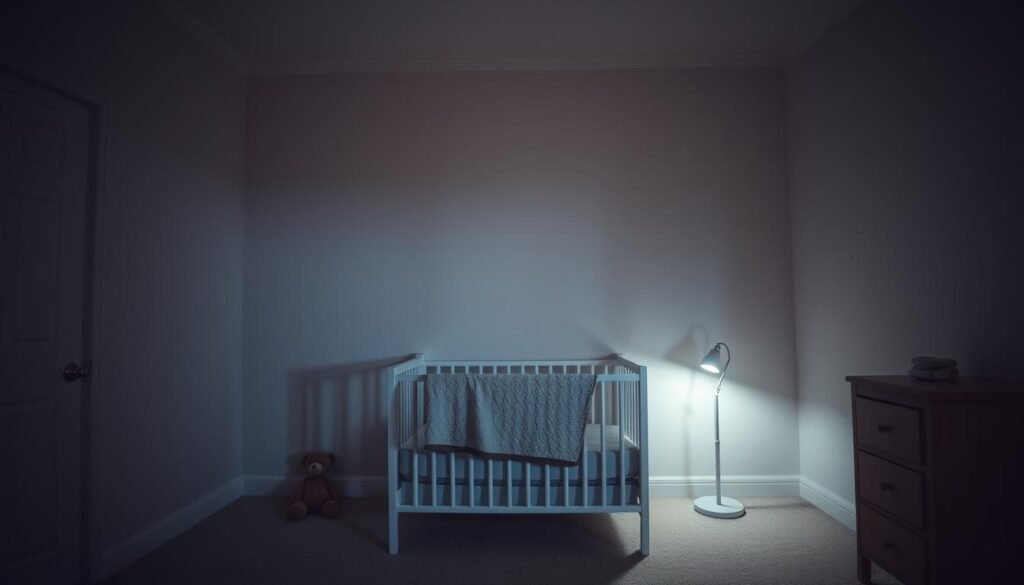I’ve been looking into the Ferber Method for sleep training. It’s a popular way to help babies learn to sleep alone. This method involves letting a baby cry for longer periods to teach them to fall asleep by themselves. It’s great for setting a bedtime routine and improving sleep for both babies and parents.
Many wonder when to start the Ferber Method. Dr. Ferber suggests starting when the baby is 3 – 4 months old. But some say wait until they’re at least 6 months old. I’m curious to know the best time to start and if it works for toddlers and preschoolers too.
Exploring the Ferber Method, I see it’s more than just letting a baby cry. It’s about teaching them to soothe themselves. At first, it might seem scary, but with the right approach, it can change a family’s life. I’m excited to share more about my experience with the Ferber Method and how it can help everyone sleep better.
Understanding the Ferber Method for Sleep Training
The Ferber Method is a well-known sleep training technique. It involves parents leaving their child for longer periods until they fall asleep alone. This method helps babies learn to self-soothe and sleep independently.
What Is the Ferber Method?
Dr. Richard Ferber introduced the Ferber Method in 1985 through his book “Solve Your Child’s Sleep Problems.” It’s a gentle approach that helps babies sleep without help.
How the Method Works
The method starts with a bedtime routine and then leaves the baby to sleep alone. It uses a progressive waiting approach. For example, Dr. Ferber suggests checking on the baby at intervals like 3 minutes, 5 minutes, and so on.
The Science Behind Progressive Waiting
Studies show that sleep training, like the Ferber Method, can make kids more willing to sleep. It also reduces nighttime wake-ups and has lasting effects. The Ferber Method usually stops crying in about three to seven nights.
- Improved sleep quality for both babies and parents
- Increased independence for babies
- Reduced stress for caregivers
The Ferber Method is a gentle way to help babies sleep alone. By using a progressive waiting approach and a consistent bedtime routine, parents can improve their baby’s sleep and well-being.
| Age | Sleep Training Method | Benefits |
|---|---|---|
| 6 months | Ferber Method | Improved sleep quality, increased independence |
| 12 months | Gentle sleep training | Reduced stress for caregivers, improved sleep quality |
The Ideal Age Window for Starting Sleep Training
Choosing the right time to start sleep training is key for improving baby sleep. Dr. Ferber suggests starting when babies are 3-4 months old. By then, they are physically and mentally ready to learn self-soothing and sleep alone.
Experts say the best time is between 4 to 6 months. Babies can sleep for long stretches without waking up for food. But, they still need comfort to fall asleep. The ferber method steps help babies learn to sleep on their own.
Here are some key points to consider when determining the ideal age for sleep training:
- By 4 months old, most babies can sleep for six hours between feeds overnight.
- By 6 months, most children can sleep through the night.
- It typically takes between three to seven nights to train a baby with a sleep training method.
Studies show sleep training is safe and healthy for babies. It helps them develop good sleep habits. With patience and consistency, parents can guide their babies to sleep well using the ferber method steps.
Every baby is different, so what works for one might not work for another. Stick with the chosen sleep training method for two full weeks. If you’re worried about your baby’s sleep, talk to a pediatrician.
| Age | Sleep Capability |
|---|---|
| 4 months | Sleep for six hours between feeds overnight |
| 6 months | Sleep through the night |
Signs Your Baby Is Ready for Sleep Training
As a parent, knowing when your baby is ready for sleep training is key. It’s a big step, but with the right steps, it can change your life and your baby’s. A big sign is if your baby can calm down on their own after being upset. This shows they’re ready to start sleep training.
Also, check if your baby can roll over and sleep at regular times. If they show interest in their bed and can settle down after being placed there awake, they’re likely ready. Watching for these signs helps you know the best time to start sleep training.
Other signs your baby might be ready for sleep training include:
- Being fussy during bedtime
- Sleep props not working well
- More nighttime wake-ups
- Showing signs of self-soothing
By spotting these signs and starting sleep training at the right time, you can help your baby sleep better. Remember, every baby is unique, and what works for one might not work for another. But with patience, consistency, and the right approach, your baby can learn to sleep through the night.
| Age | Signs of Readiness |
|---|---|
| 3-4 months | Ability to self-soothe, regular sleep schedule |
| 5 months | Physical readiness, interest in bed or crib |
Essential Preparations Before Starting the Method
Starting the Ferber Method requires a solid plan. I need to set up a bedtime routine and make sure the sleep area is perfect. It’s also important to be consistent. This helps a lot with the cry it out method and gentle sleep training.
Creating a bedtime routine is a big step. It tells my baby it’s time to sleep. This makes the transition easier.
It’s also crucial to make the sleep area dark, quiet, and just right. This helps my baby learn to sleep on their own. Being consistent is key. It helps my baby learn to fall asleep by themselves.
Some important things to think about include:
- Establishing a consistent bedtime routine
- Creating a sleep-conducive environment
- Being consistent in implementing the Ferber Method
By following these steps and staying committed, I can help my baby sleep better. This will make our whole family happier.

Every baby is different, and what works for one might not work for another. It’s important to be patient and flexible. This way, I can help my baby develop good sleep habits for life.
Creating the Perfect Sleep Environment
When it comes to ferberizing, the sleep environment is key. As a parent, I know how important it is. A comfy temperature, dark room, and quiet space help a lot. These things help your baby sleep better and stay asleep longer.
To make the perfect sleep space, think about these things:
- Temperature: Keep the room at a comfy 68-72°F (20-22°C) for better sleep.
- Lighting: Make sure the room is dark. Light can mess with melatonin, the sleep hormone.
- Noise: Use white noise machines or a fan to block out background sounds.
By using these sleep training techniques, you can make a sleep-friendly space. Remember, being consistent is crucial. With patience and effort, your baby will learn to sleep well on their own.
| Factor | Description |
|---|---|
| Temperature | Keep the room at a comfy temperature, between 68-72°F (20-22°C) |
| Lighting | Ensure the room is dark to promote melatonin production |
| Noise | Minimize noise levels using white noise machines or a fan |
Step-by-Step Implementation Guide
To start the ferber method, create a bedtime routine. This signals to the baby it’s time for sleep. Activities like bath time, reading, or singing are good choices. They help create a calm atmosphere for sleep.
After setting up the bedtime routine, begin the ferber method. Leave the baby to fall asleep alone, starting with short intervals. Begin with 3-5 minutes and increase it over days. This teaches the baby to fall asleep by themselves, improving their sleep.
Here are the key steps for the ferber method:
- Establish a consistent bedtime routine
- Start with a short interval, such as 3-5 minutes, and increase the time over the next few days
- Leave the baby to fall asleep on their own, but return to check on them at increasingly longer intervals
- Be consistent and patient, as it may take some time for the baby to adjust to the new sleep routine
By following these steps, parents can help their babies sleep better. Always keep the baby’s safety first and be ready to adjust the method if needed.
The ferber method can greatly improve baby sleep with time and consistency. Stay committed and make adjustments as necessary for the best results.
| Day | Interval | Actions |
|---|---|---|
| 1 | 3-5 minutes | Leave the baby to fall asleep on their own, then return to check on them |
| 2 | 5-10 minutes | Increase the interval and continue to leave the baby to fall asleep on their own |
| 3 | 10-15 minutes | Continue to increase the interval and leave the baby to fall asleep on their own |
Common Challenges and Solutions
Every parent faces unique challenges when it comes to sleep training. The Ferber Method can be tough, with issues like prolonged crying, nighttime feedings, and sleep regressions. Having sleep training advice and a gentle approach is key.
Dealing with prolonged crying is a big challenge. It’s hard to hear your baby cry, but it’s part of learning. To tackle this, create a consistent routine and a sleep-friendly environment.
Dealing with Prolonged Crying
Here are some helpful tips:
- Check on your baby at longer intervals to reassure them
- Make sure the room is dark, quiet, and comfy
- Keep the bedtime area calm and free from stimulation
By using these tips and gentle sleep training, your baby can learn to fall asleep on their own.
Managing Nighttime Feedings
Nighttime feedings can be tough, especially for breastfeeding moms. The Ferber Method aims to help your baby sleep without feedings. It’s important to have a regular feeding schedule and slowly cut down on nighttime feedings.
Modifying the Ferber Method for Different Ages
Exploring ferberizing shows that sleep training isn’t the same for everyone. The Ferber Method, which involves waiting in steps, can be changed for different ages. This includes toddlers and preschoolers, and even older kids.
It’s key to think about the child’s age and what they need when changing the Ferber Method. For older kids, using a gate or setting clear rules can help them sleep alone. Some parents like a slow approach to sleep training, while others prefer a more set method.
Here are some tips for changing the Ferber Method for different ages:
- For toddlers, use a consistent bedtime routine and set clear rules.
- For preschoolers, let them choose things like pajamas or bedtime stories.
- Be flexible and adjust the method as needed for the child’s unique needs and personality.

By changing the Ferber Method for the child’s age and needs, parents can help them develop good sleep habits. Remember, sleep training for babies is a personal choice. What works for one family might not work for another. With patience, consistency, and the right approach, parents can help their children sleep well and grow.
Tracking Progress and Making Adjustments
Using the Ferber Method for sleep training has shown me how key it is to track progress and adjust as needed. I keep sleep logs to watch my baby’s sleep patterns and find areas to improve. This helps me tweak the Ferber Method to make it work better.
The cry it out method has been a big help for me. It lets my baby cry for a bit before I step in. But, it’s important to find the right balance. I track progress and adjust to see if this method is right for my baby or if I need to change things up.
Using Sleep Logs
Sleep logs have been a game-changer for me. They help me see my baby’s sleep patterns and find ways to improve. By noting when they fall asleep, wake up, and how long they sleep, I can spot patterns. This helps me adjust the Ferber Method to fit my baby’s needs better.
When to Modify Your Approach
Being flexible and ready to change the Ferber Method is crucial. If my baby isn’t responding well or if their sleep environment changes, I might need to adjust. This could mean tweaking the cry it out method or trying something new. By being open to change and tracking progress, I can help my baby develop good sleep habits.
Here is a sample sleep log that I use to track my baby’s sleep patterns:
| Date | Sleep Time | Wake Time | Sleep Duration |
|---|---|---|---|
| Monday | 8:00 PM | 6:00 AM | 10 hours |
| Tuesday | 8:30 PM | 6:30 AM | 10 hours |
| Wednesday | 9:00 PM | 7:00 AM | 10 hours |
Alternative Sleep Training Methods to Consider
Every family is different, and what works for one might not work for another. If you’re exploring other sleep training methods, there are many options. Gentle sleep training methods, like the “no tears” approach, aim to create a sleep-friendly space. They also focus on setting up a bedtime routine without leaving the baby to cry alone.
The “chair method” is another option. It involves sitting next to your baby’s bed and slowly moving the chair further away. This gentle method helps your baby learn to fall asleep on their own. When choosing a sleep training method, remember to think about your baby’s unique needs and personality.
Some other sleep training methods include:
- The “camping out” approach, which helps your baby transition from a crib to a bed
- Bedtime fading, which adjusts your baby’s bedtime to help them learn to self-soothe
- Scheduled awakenings, which wakes your baby at set times to teach them to fall back asleep
Consistency and patience are key to successful sleep training. With the right approach and sleep training advice, your baby can develop healthy sleep habits for life.
Conclusion: Making the Right Choice for Your Family
The Ferber Method is a well-known sleep training technique. But remember, every family and child is different. What works for some might not work for others.
It’s important to keep an open mind when trying sleep training. Think about your child’s personality and what feels right for your family. This way, you can find the best approach for you.
Choosing the Ferber Method or another technique is up to you. The key is to be consistent, patient, and supportive. A calm sleep environment and loving parents can help your child sleep well.


